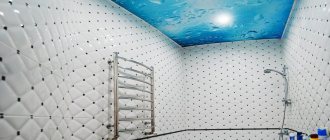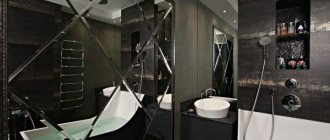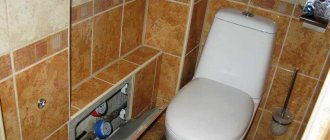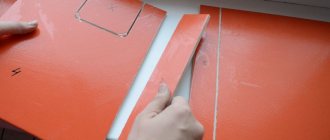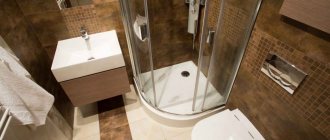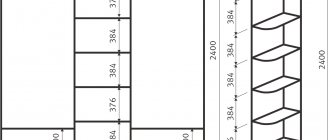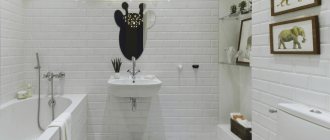Painting is one of the simplest and most popular ways to decorate the ceiling yourself, including in the bathroom. But not every paint is suitable for such operating conditions, namely high humidity and elevated temperatures. If the paintwork material does not meet these requirements, then many inconveniences arise: more frequent repairs, the inability to properly wash the surface, the appearance of mold and mildew. Let us examine in detail which paint is best to paint the ceiling in the bathroom, the advantages and disadvantages of different compositions, as well as the subtleties of self-repair.
What kind of paint should you definitely not use?
Below we will look at which paint is better to choose, but now we’ll talk about which one you definitely shouldn’t take.
Under no circumstances use oil paint or enamel, as they do not breathe and form a single film. Water does not seep through them, but micro-droplets collect on the surface, and this means only one thing - “fungus” or simply peeling of the paint itself is not far off. Literally bubbles.
Also, don't skimp on the paint's water-resistant properties. It doesn't cost much more, but it will last much longer. That's all there is to avoid when purchasing.
Choosing the Right Paint
There are not many types of paints. Let's look at them so that you go to the store already prepared.
Water-based paints are the most common and inexpensive option. It fits perfectly and has no smell at all.
In bathrooms they use waterproof emulsion, since the usual one is afraid of moisture and deteriorates very quickly in such conditions. The paint is easy to apply, very easy to mix with dye, but it has a significant disadvantage - it cannot be washed.
By and large, it is in the bathroom that there is rarely a need to wash the ceiling. It is always enough to walk over it with a dry, clean cloth. This is not a kitchen, where food splashes can stain the surface at any moment.
Acrylic paints are a better option. You can wash it, but not every day, of course, and not with metal sponges. The paint also applies well, it is more dense, therefore, it perfectly covers small cracks and unevenness in the putty.
Just small ones, don’t expect it to cover a poorly prepared ceiling. It has a chemical smell, unlike a simple water-based emulsion. But it fades quickly.
Very often acrylic waterproof paints contain anti-fungal additives. It is very rare if this is not the case, but still, be sure to ask the seller about this point.
Latex paints - for some reason they are always separated into a separate row, however, they are the same acrylic paint. It’s just even more dense and elastic. Otherwise, it has the same properties as a regular one, except that you can wash it a little more often (but still, without fanaticism).
Silicate or silicone paints - these paints are so dense that they can hide a crack two millimeters thick. In general, the option is, of course, very tempting, but since this paint is very expensive, and a two-millimeter crack is not so disturbing to life, it is better to get by with something more affordable.
If for this price it would equal the ceiling instead of putty, then we could take it. And so... There is no point.
In general, from all of the above it turns out that the best option today is acrylic paint.
We figured out what paint to buy. Now let’s touch on the question of how exactly to paint the bathroom ceiling.
Compositions used
Not all coloring agents meet the requirements for ceiling coverings for bathrooms. Before purchasing material, you should study the list of suitable compounds.
Acrylic based
After drying, this paint forms a durable coating that is resistant to temperature changes and moisture. The layer of the composition resembles a plastic film that protects the base. The paint is suitable for bathrooms and other rooms with high humidity. Manufacturers offer 15,000 color options, which allows the products to be used in the design of any interior. Acrylic paint is a priority option when processing plasterboard multi-level structures.
Water-emulsion and water-dispersion
Such paints are safe to apply and use. Most often they are produced in the form of a white base, to which color is added. The main disadvantage is considered to be instability to abrasion. When using detergents, the material is quickly washed off. When exposed to moisture, the coating may deteriorate.
Latex and silicone paint
Latex-based compositions are considered a type of acrylic. They are characterized by a dense elastic texture. After drying, a durable film is formed that is insensitive to moisture. In terms of environmental safety, latex compositions are not inferior to acrylic ones. They are capable of covering defects up to 1 mm thick. The paint adheres well to the surface and dries quickly. However, with prolonged use, the coating may fade.
Silicone compounds are made on the basis of polymers and combine the advantages of latex and acrylic products. They do not fade under the influence of sunlight, do not crack, and do not wear out over time. Silicone paints are not used for finishing metal and wooden substrates.
Alkyd compositions
Such products have replaced oil products. The advantages of alkyd enamels include:
- quick drying;
- resistance to temperature changes;
- maintaining brightness when exposed to sunlight;
- insensitivity to moisture;
- Compatible with most types of bases.
Manufacturers offer alkyd products in different colors. The compositions are matte, semi-gloss or glossy. The material does not allow air to pass through, which is considered the main disadvantage. The paint forms a continuous hydrophobic film; condensation collects on the surface, contributing to the destruction of the layer. Another disadvantage is the strong smell, which makes working in small rooms difficult.
Based on PVA glue
Fire safety is considered the main advantage of such paints. However, with constant exposure to water, the coating is washed off. PVA-based products do not mix well with color; only light shades are obtained.
The finished coating is sensitive to mechanical damage and sunlight. Therefore, the surfaces will have to be updated every 2 years.
Silicate paints
Such finishing materials are made on the basis of glass. They dry quickly, forming a durable, safe, vapor-permeable coating. The main disadvantage is the small number of tones. Therefore, such materials are most often used for outdoor work.
Which is better to paint: smooth or textured?
Surely you know that there are now special, shaped rollers on sale that allow you to apply paint not in a smooth way, but in a shaped way: in dots, stripes, etc.
This is all, of course, very beautiful, but do not forget that a bath is a bath, and floods and other troubles happen in it much more often than in other rooms.
Let’s say if your upstairs neighbors flood you, just a little, an ugly stain will form on the ceiling.
If the coating is ordinary, it costs you nothing to tint this piece, but a curly coating is not so easy. The same goes for a small spot of “fungus”.
It’s not a fact that after many years you will still have the same roller, it’s not a fact that it won’t dry out (even if you find it) and you won’t have to go buy another one... In general, it’s a complete headache, but the effect, to be honest, is almost none.
An even, smooth ceiling always looks more elegant than a textured one.
Dyeing technology
Almost all modern paint and varnish products can be applied to the surface to be painted mechanically and by air. That is, after covering the adjacent sections of the walls with masking tape and a brush, painting is done in the corners.
Then the water-based emulsion is applied to the entire surface with a roller, spray gun, brush or spray, taking into account the following nuances:
- the minimum number of layers is 2; with low hiding power or a light color of paint on a dark primer, 3 or more layers will be required;
Applying paint with a roller to the bathroom ceiling.
- layers are applied at right angles to each other, the first is usually across the room, finishing from the front door to the far wall of the bathroom.
Scheme of the sequence and direction of layers.
You should not force dry each layer; it is enough to ensure the room is ventilated naturally.
Advice! If you need bathroom renovation specialists, there is a very convenient service for selecting specialists from PROFI.RU. Just fill out the order details, the experts will respond and you can choose who to collaborate with. Each specialist in the system has a rating, reviews and examples of work, which will help with the choice. Looks like a mini tender. Placing an application is FREE and does not oblige you to anything. Works in almost all cities of Russia.
If you are a master, follow this link, register in the system and be able to accept orders.
What color should I paint the bathroom ceiling?
If you have a small bathroom, which is often the case in typical apartments, it is better to stick to a regular white color.
Firstly, it visually increases the space and even the height seems a little larger.
And secondly, from a purely practical point of view, repainting and tinting it in this case is easier. It is not always possible to select the exact color tone (in the case of flooding), therefore, you will have to “roll” the entire ceiling.
What to choose: matte or glossy paint?
Acrylic paints come with a matte or glossy effect. The second ones are a little more expensive, but they look more elegant.
The gloss there is not so sparkling as to have enormous reflective abilities, therefore, there is not much difference in the choice.
Let's say the same glossy stretch ceiling will cause great discomfort in the bathroom, since it has the ability to display glare from lighting fixtures. Lying in the bathroom, you often look up and the glare from the spots unpleasantly “hurts” your eyes.
In the case of paint, such inconveniences will not arise, since it shines, but does not have a mirror effect.
But there is a minus here: every grain of sand and unevenness is visible on the gloss. Agree, it is very rare when the ceiling is prepared so well that there is not a single smallest bulge.
But the matte surface is more “velvety”, therefore, the ceiling will look perfect, even if there are small errors on it. Moreover, as you remember, acrylic paint lays down in a rather dense layer.
Which company is better to choose?
We do not recommend that you save much on paint. It is always better to give preference to brands that have been proven for decades.
By the way, even if they are more expensive, it is not so significant that this factor turns out to be decisive.
Paints from German manufacturers have proven themselves to be the best.
The coating lasts for at least 5-7 years, while more inexpensive options begin to deteriorate after 3-4 years (if not earlier). So consider that it is actually cheaper. It’s trite, but the miser pays twice.
Also remember that taking paints from markets is extremely dangerous. In construction markets there are conditions for storing them, but in cold and hot weather there are no conditions, therefore, there even the freshest paint can be spoiled and “lay down” unevenly on the surface.
In principle, weather factors will not affect the quality of the water emulsion, but acrylic may well “delaminate.”
Recommendations from the experts
Experts give the following tips for painting the ceiling in the bathroom:
- It is worth giving preference to coloring agents containing antiseptic additives. If mold penetrates deeply, remove the plaster to the base before painting. Before applying a new leveling layer, the floor slab is treated with a fungicidal agent, for example, Teflex. Chlorine-containing bleaches are also used.
- It is not recommended to save the coloring agent. The composition applied in several layers forms a durable, uniform coating. Each subsequent layer is formed only after the previous one has completely dried.
- If there are rusty streaks or stains, paint the ceiling in a darker tone. You can purchase special anti-smudge paint, for example, “Snezhka”. It is used for both preliminary and finishing treatment of ceilings.
To ensure that the finishing material adheres well to the ceiling, use a primer of the same brand as the paint. When applying the product, do not take long breaks. When painting, regularly inspect the ceiling, identifying unpainted areas.
How to prepare the ceiling before painting?
The theory is over, let's now move on to the practical part. Before painting the ceiling, it needs to be leveled and prepared, everyone knows this.
But, in order for the coating to last long enough, you need to do antifungal prevention of the concrete surface. Moreover, it doesn’t matter what kind of paint you use: with anti-mold additives or not.
You still need to do this, but here you look at the degree of “severity”. If your bathroom is well ventilated (which is very rare), then you can get by with ordinary copper sulfate, which must first be used to treat the ceiling.
If mold in your room tends to “settle”, then it is better to resort to more effective and “long-lasting agents”, for example, special antifungal plasters and putties.
Preparatory work
Painting should begin with preparing the base. If preparation is poor, the painted layer may fall off in the future. The scope of work depends on the condition of the ceiling, but in general the general procedure will not change.
- Cleaning the base involves removing the old coating. If painting is being done for the first time, then you just need to remove dirt, dust and cobwebs. If there is whitewash on the ceiling, it must be washed off.
Removing old whitewash with a sponge.
Whitewashing in damp rooms is a common mistake in renovations. When in contact with moisture, lime crystallizes, resulting in reduced adhesion to the surface. The whitewash layer falls off along with the topcoat.
- The whitewash is washed off with warm water using an old rag, sponge or washcloth.
- Further work order may differ depending on the condition of the ceiling. Cracks and holes can be repaired using putty. The surface is primed with a deep penetration compound. Depending on the manufacturer's recommendations, the primer is applied twice, but be sure to wait until the first layer dries.
Puttying the ceiling
- If the ceiling is uneven, then a layer of plaster is applied to it. If the layer thickness is more than 1 cm, a TsPVS mesh is fixed. The plastered surface is re-primed and puttied several times with a break for drying.
If the renovation of the bathroom is not the first time, then the procedures for leveling the ceiling can be skipped.
- Special heat-insulating linings must be installed on the heating pipes; they will protect the plaster from cracking.
Which putty should I choose for leveling?
If your bathroom is small, then overpaying the craftsmen for leveling the surface is simply a shame. These two or three squares don’t cost anything to do on your own.
Here you don’t need any special mesh or skills, since there are no inter-tile gaps or any differences in the bathrooms.
The main thing here is good building material and a spatula. It is advisable to use silicone-based putty; it applies just perfectly, has a pure white color, and the result is an eggshell effect.
This is very important, since with such a base the defects in the painting will not be very noticeable. And you will need fewer layers (often just one layer of acrylic paint is enough).
Tools, workwear
When performing preparatory work you will need:
- a small spatula to remove the old layer of paint;
- coarse and fine-grained sandpaper;
- medium spatula (malka) for applying plaster;
- drill with an attachment for making plaster mixture;
- stepladder or small scaffolding;
- roller or brush to apply a layer of primer.
For direct painting you will need:
- roller with short fur – 2 pcs.;
- small and large paint brush;
- tray for paint (primer).
From clothes and specials. funds you need to have:
- painter's overalls, preferably with a hood;
- glasses;
- gloves;
- respirator.
